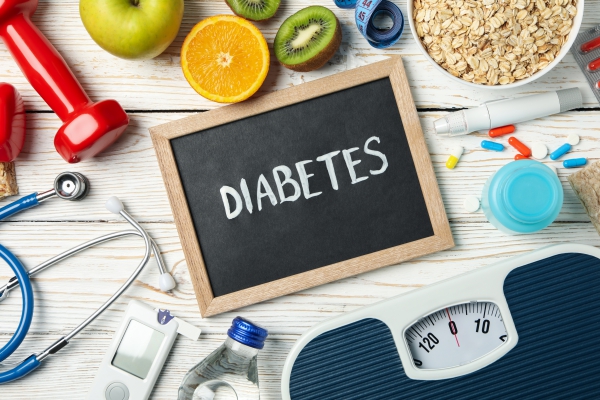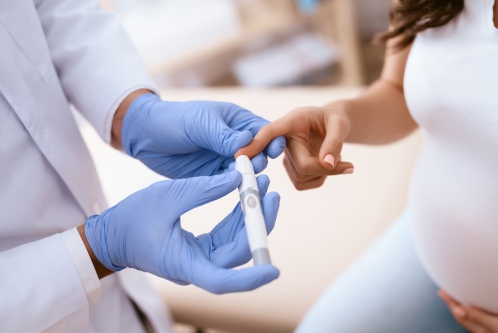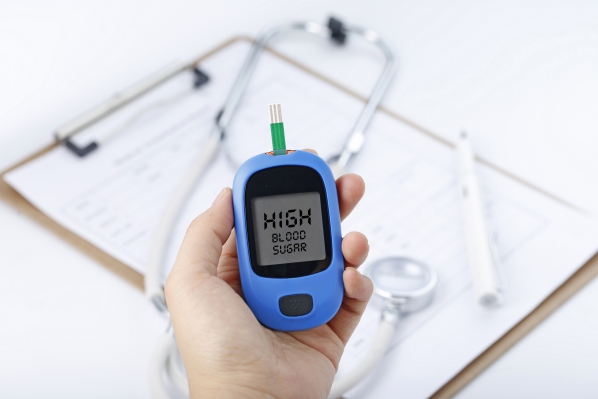What is type 2 Diabetes mellitus?
Type 2 Diabetes mellitus is a lifelong medical condition in which your body becomes resistant to a hormone called insulin. Insulin is released from a gland called the pancreas and its function is to make your body use up sugar (or glucose) that you consume every day.
When your body becomes resistant to insulin, the latter can no longer perform its function and thus results in glucose accumulating in your bloodstream to abnormally high levels. In the long run, changes in your pancreas will lead to less insulin being produced.
This type of diabetes most commonly affect middle-aged or old people and can also be called adult-onset diabetes. However, it can also arise among children and teenager especially among those who are obese.
If not managed appropriately, uncontrolled diabetes can lead to some serious complications with sometimes, irreversible effects. Therefore it is important to maintain a healthy lifestyle as well as abiding to what your doctor prescribed.
Causes of type 2 Diabetes mellitus
As explained earlier, Type 2 Diabetes results from the development of insulin resistance. Initially, your body will respond by producing more and more insulin to compensate, but since the problem is with the cells that do not respond to insulin, this will fail to work and you will end up with high amounts of glucose in your blood circulating through all of your organs.

The exact cause of Type 2 Diabetes is still unknown, however, a combination of several factors can lead to the development of the disease including:
- Obesity: Your risk of having Type 2 diabetes increases if you are overweight or obese. This can be known by calculating your body mass index (BMI).
- Genes: There are certain genes that can predispose you to develop diabetes.
- Environmental pollutants: some studies have shown that these can contribute to the development of Type 2 diabetes.
- Non-functioning beta cells: Beta cells are the cells present in your pancreas that produce insulin. If these cells do not function properly, the blood sugar levels will increase. This high blood sugar can cause further damage to the cells in the pancreas.
- Metabolic syndrome: This usually occurs in people with insulin resistance where they end up having a group of conditions including high blood pressure, increased blood sugar, high cholesterol, and excessive abdominal fat.
Who are at risk of getting Type 2 Diabetes?
You have a higher risk of developing Type 2 diabetes if you:
- are aged 45 years old or higher
- have close relatives (parent, sister, brother) having diabetes
- have a history of diabetes during pregnancy.
- have a condition called polycystic ovarian syndrome
- are pre-diabetic (high blood sugar but not high enough to be diagnosed as diabetic)

Sign and symptoms
This condition develops insidiously. Initially, the symptoms may go unnoticed but will slowly become impairing and will require medical help. The initial symptoms may include:
- Frequent urination
- Dry mouth and excessive thirst
- Tendency to eat a lot
- Unexplained weight loss
- Blurring of vision
- Numbness in the lower limbs
- Frequent infection especially of the genitals
- Fatigue
In the long run, the symptoms become more apparent and impairing. The following may occur due to chronically high amount of sugar in the blood:
- Wounds taking a lot of time to heal
- Frequent yeast infections
- Skin changes with the appearance of dark rashes around the neck and under the armpit known as acanthosis nigricans
- Pain in the foot with or without tingling and numbness (neuropathy)
High blood sugar can affect almost all organs in your body hence the need to strictly keep your blood sugar levels within the acceptable ranges.
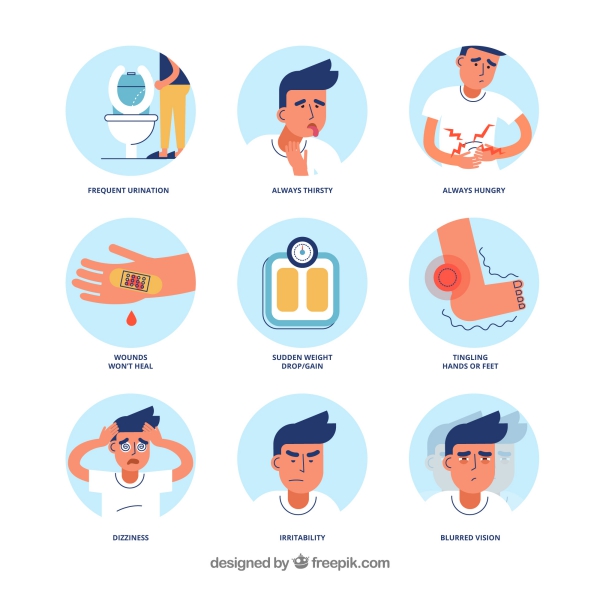
Making a diagnosis
If you go to your doctor’s office presenting with signs and symptoms of Type 2 diabetes, the latter will have to test for the level of glucose in your blood by taking a blood sample. Usually, the test is done on two different occasions to confirm the diagnosis unless your blood sugar level is already very high on the first test. There are different tests that can be done to confirm the diagnosis of diabetes namely:

- Fasting plasma glucose test: This test measures the level of glucose in your blood and is done after having fasted for at least 8 hours.
- Hemoglobin A1C test: Also known as glycosylated hemoglobin test, this test is an average of your blood glucose levels for the past 3 months. You are not required to fast prior to this test.
- Oral glucose tolerance test: For this test, your blood samples are taken 3 times; before, one hour after and two hours after drinking a given dose of glucose solution. The findings demonstrate how your body responds to a peak of glucose in the blood.
A fasting blood sugar of less than 5.6 mmol/L is normal. A fasting blood sugar between 5.6 and 6.9 mmol/L is considered as prediabetes. If it exceeds 7 mmol/L on two different occasions, you have diabetes.
A Hemoglobin A1C higher than 6.5% on two different occasions confirm the diagnosis of diabetes.
Treatment of Type 2 Diabetes
Once you have been diagnosed with diabetes, your doctor will provide you with explanations on diet change, recommended physical activities, how to monitor your blood sugar levels at home and the medications that need to be taken. It is of upmost importance to correctly control your blood sugar levels to prevent occurrence of unwanted complications.
The first level of management of diabetes is lifestyle modifications. In some cases, only these changes can help in controlling your blood sugar levels. This includes:

- Having a healthy diet: Increase the amount of fibre in your diet along with fruits and vegetables. Restrict your consumption of saturated fats and sugary foods. It is also important to eat at regular intervals and avoid overeating. You can also start decreasing the amount of calories you consume or practise portion control. This can be achieved with the help of a dietician.
It is important to avoid certain foods such as beef or liver, processed foods, bakeries, fried foods, dairy products with high amount of fat, pasta and white rice. Choose whole grains such as oats or quinoa, food with omega-3 fatty acids like tuna, salmon, cod or mackerel.
- Exercising regularly: It is recommended to have around 30-60 minutes of physical activity per day. Brisk walking, cycling or swimming or any other activity that helps pumping the heart faster is advised. It would be better to talk about it to your doctor first to know if you can perform certain physical activities depending on your general health condition. If you were not active for a long period of time, start slowly and gradually build up.
- Losing weight: Weight loss has been associated with decreasing Hemoglobin A1C levels in patients with type 2 diabetes mellitus. The combination of portion control and regular physical exercise can help to drop off some extra pounds.
- Watching your blood sugar levels: Once you are diagnosed with diabetes, it is important for you to learn how to check for your blood sugar levels and how often to do it. Your doctor will explain to you how to proceed.

Despite all these changes, sometimes it still remains difficult to control your blood sugar levels and other measures should be implemented to avoid the development of complications in the long term. This is when your doctor will start to prescribe you some medications. The most commonly used drugs for Type 2 Diabetes include:
- Metformin which works by lowering your blood glucose levels and increase the body’s response to the hormone insulin. It is generally the first medication prescribed in patients with Type 2 Diabetes.
- Sulfonylureas works by increasing the amount of insulin secreted by the beta cells of the pancreas.
- Meglitinides also work by increasing the amount of insulin in the body but work faster compared to sulfonylureas.
- Thiazolidinedione works the same way as metformin by increasing the body’s sensitivity to insulin. However, these drugs can increase your risk of having a heart problem.
- Dipeptidyl peptidase-4 inhibitors (DPP4 inhibitors) also help to lower blood glucose levels.
- Glucagon-like peptide-1 (GLP-1) receptor agonists work by slowing down digestion hence lowering blood glucose levels.
- Sodium-glucose cotransporter 2 (SGLT2) inhibitors which allow more glucose to be removed from the body through your urine.
- Insulin injections will be required if the body is no longer able to produce insulin or is not able to produce enough of it.
 You may experience some undesirable side effects with the medications above and it may need some time before finding the treatment which will suit you best, taking into consideration any other medical conditions you may be having.
You may experience some undesirable side effects with the medications above and it may need some time before finding the treatment which will suit you best, taking into consideration any other medical conditions you may be having.
Complications of Type 2 Diabetes
If not controlled adequately several complications may arise as high blood sugar circulating through organs can be damaging to the cells of those organs. The only way to avoid ending up with complications is to strictly keep your blood sugar levels within the acceptable range. The most common complications include:
- Kidney problems such as kidney failure, meaning that your kidney is not able to function properly. You will then be requiring dialysis or kidney transplant.
- Eye problems may arise as the tiny blood vessels present in your eyes will be damaged. This can worsen till blindness is established.
- Non healing wounds are very common among diabetic patients. These occur following poor circulation in addition with decreased sensation in the feet. The decreased sensation may contribute in some cuts and sores going unnoticed.
- Heart and blood vessels are also affected by high blood sugar levels. There is an increased risk of having a heart disease or a stroke if you have diabetes.
- Nerve damage is a common complication giving rise to decreased sensation, tingling and numbness in your limbs.
- Hearing can also be affected by diabetes.
Prevention of Type 2 Diabetes
Even if you cannot always prevent the disease, some actions can help delay or even, in some fortunate cases, prevent its onset. These actions include:

- Limiting sugar consumption by avoiding sugary foods or drinks
- Consume less harmful fats
- Exercising regularly
- Maintaining a healthy weight
These measures should be implemented the earlier possible and should be taken seriously if you are pre-diabetic.
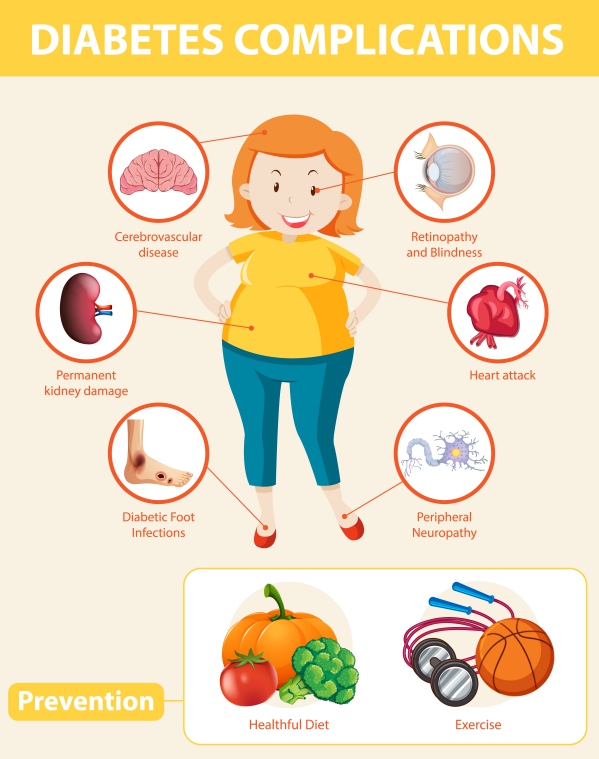
Source:
J. Alastair, I. and Simon, M., 2016. Davidson's Essentials of Medicine. 2nd ed. London: ELSEVIER.
Parveen, K. and Michael, C., 2017. Kumar & Clarks Clinical Medicine. 9th ed. The Netherlands: ELSEVIER.
McCulloch, D., and Robertson, R., 2019. Pathogenesis of type 2 diabetes mellitus
Wexler, D., 2020. Initial management of hyperglycemia in adults with type 2 diabetes mellitus


